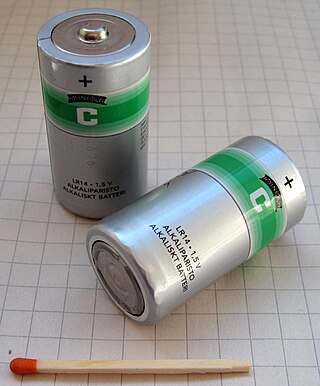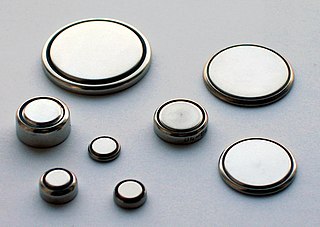
A DC connector is an electrical connector for supplying direct current (DC) power.

IEC 60320 Appliance couplers for household and similar general purposes is a set of standards from the International Electrotechnical Commission (IEC) specifying non-locking connectors for connecting power supply cords to electrical appliances of voltage not exceeding 250 V (a.c.) and rated current not exceeding 16 A. Different types of connector are specified for different combinations of current, temperature and earthing requirements. Unlike IEC 60309 connectors, they are not coded for voltage; users must ensure that the voltage rating of the equipment is compatible with the mains supply. The standard uses the term coupler to encompass connectors on power cords and power inlets and outlets built into appliances.
The Unified Thread Standard (UTS) defines a standard thread form and series—along with allowances, tolerances, and designations—for screw threads commonly used in the United States and Canada. It is the main standard for bolts, nuts, and a wide variety of other threaded fasteners used in these countries. It has the same 60° profile as the ISO metric screw thread, but the characteristic dimensions of each UTS thread were chosen as an inch fraction rather than a millimeter value. The UTS is currently controlled by ASME/ANSI in the United States.

The AAA battery is a standard size of dry cell battery. One or more AAA batteries are commonly used in low-drain portable electronic devices. A zinc–carbon battery in this size is designated by IEC as R03, by ANSI C18.1 as 24, by old JIS standard as UM-4, and by other manufacturer and national standard designations that vary depending on the cell chemistry. The size was first introduced by The American Ever Ready Company in 1911. They're called #7 batteries in China, the name originating from the Burgess Battery Company designating his AAA batteries "Number 7".

A screw thread, is a helical structure used to convert between rotational and linear movement or force. A screw thread is a ridge wrapped around a cylinder or cone in the form of a helix, with the former being called a straight thread and the latter called a tapered thread. A screw thread is the essential feature of the screw as a simple machine and also as a threaded fastener.

The AA battery is a standard size single cell cylindrical dry battery. The IEC 60086 system calls the size R6, and ANSI C18 calls it 15. It is named UM-3 by JIS of Japan. Historically, it is known as D14, U12 – later U7, or HP7 in official documentation in the United Kingdom, or a pen cell.

A D battery is a standardized size of a dry cell. A D cell is cylindrical with an electrical contact at each end; the positive end has a nub or bump. D cells are typically used in high current drain applications, such as in large flashlights, radio receivers, and transmitters, and other devices that require an extended running time. A D cell may be either rechargeable or non-rechargeable. Its terminal voltage and capacity depend upon its cell chemistry.
Finnish vehicle registration plates usually carry three letters and three numbers separated with a dash, though vanity plates may carry 2-3 letters and 1-3 numbers. Since 1989 the code has no connection with the geographic location, except that Åland has its own type of plate. Between 1972/1973 and 1989 the first letter indicated where the vehicle was first registered as the plate did not have to be changed even if the vehicle was moved to another area of Finland.

The C battery is a standard size of dry cell battery typically used in medium-drain applications such as toys, flashlights, and musical instruments.

The nine-volt battery, or 9-volt battery, is an electric battery that supplies a nominal voltage of 9 volts. Actual voltage measures 7.2 to 9.6 volts, depending on battery chemistry. Batteries of various sizes and capacities are manufactured; a very common size is known as PP3, introduced for early transistor radios. The PP3 has a rectangular prism shape with rounded edges and two polarized snap connectors on the top. This type is commonly used for many applications including household uses such as smoke and gas detectors, clocks, and toys.

Automotive tires are described by an alphanumeric tire code or tyre code, which is generally molded into the sidewall of the tire. This code specifies the dimensions of the tire, and some of its key limitations, such as load-bearing ability, and maximum speed. Sometimes the inner sidewall contains information not included on the outer sidewall, and vice versa.

A button cell, watch battery, or coin battery is a small single-cell battery shaped as a squat cylinder typically 5 to 25 mm in diameter and 1 to 6 mm high – resembling a button. Stainless steel usually forms the bottom body and positive terminal of the cell; insulated from it, the metallic top cap forms the negative terminal.
The ISO metric screw thread is the most commonly used type of general-purpose screw thread worldwide. They were one of the first international standards agreed when the International Organization for Standardization (ISO) was set up in 1947.

The AAAA battery is 42.5 mm long and 8.3 mm in diameter. The alkaline cell weighs around 6.5 g and produces 1.5 V. This size battery is also classified as R8D425 (IEC) and 25 (ANSI/NEDA). The alkaline battery in this size is also known by Duracell type number MN2500 or MX2500 and Energizer type number E96.

A coaxial power connector is an electrical power connector used for attaching extra-low voltage devices such as consumer electronics to external electricity. Also known as barrel connectors, concentric barrel connectors or tip connectors, these small cylindrical connectors come in an enormous variety of sizes.

Automotive fuses are a class of fuses used to protect the wiring and electrical equipment for vehicles. They are generally rated for circuits no higher than 32 volts direct current, but some types are rated for 42-volt electrical systems. They are occasionally used in non-automotive electrical products. Automotive fuses are typically housed inside one or more fuse boxes within the vehicle, typically on one side of the engine compartment and/or under the dash near the steering wheel. Some fuses or circuit breakers may nonetheless be placed elsewhere, such as near the cabin fan or air bag controller. They also exist as circuit breakers that are resettable using a switch.
In electrical engineering, IEC 60269 is a set of technical standards for low-voltage power fuses. The standard is in four volumes, which describe general requirements, fuses for industrial and commercial applications, fuses for residential applications, and fuses to protect semiconductor devices. The IEC standard unifies several national standards, thereby improving the interchangeability of fuses in international trade. All fuses of different technologies tested to meet IEC standards will have similar time-current characteristics, which simplifies design and maintenance.

An N battery is a standard size of dry-cell battery. An N battery is cylindrical with electrical contacts on each end; the positive end has a bump on the top. The battery has a length of 30.2 mm (1.19 in) and a diameter of 12.0 mm (0.47 in), and is approximately three-fifths the length of a AA battery.

The A-series light bulb is the "classic" glass light bulb shape that has been the most commonly used type for general lighting service (GLS) applications since the early 20th century. It has a pear-like shape and is typically fitted to either an Edison screw or a bayonet cap base. The number that follows the "A" designation indicates the nominal major diameter of the bulb, either in one-eighth inch units in North America or in millimeters in the rest of the world.





















